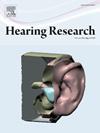Transcriptomic change in human utricles after aminoglycoside-induced hair cell ablation: Dynamic alterations to hair cell and supporting cell genes
IF 2.5
2区 医学
Q1 AUDIOLOGY & SPEECH-LANGUAGE PATHOLOGY
引用次数: 0
Abstract
Losing sensory hair cells from the mammalian inner ear results in deafness and balance disorders. A major cause of acquired hair cell loss is the use of ototoxic drugs, including aminoglycoside antibiotics. Aminoglycosides are commonly prescribed, and are highly effective and cheap, but they specifically kill hair cells. In mammals, the capacity to regenerate hair cells is extremely limited, with only a small fraction being replaced in the vestibular system. Therefore, the functional deficits arising from their loss are permanent. To date there are no therapeutic strategies to prevent hair cell loss or restore them. Whilst most studies in this area have focused on murine or avian models, these may not fully recapitulate the complexity of human disease. Improved understanding of the underlying pathology and of how human tissues respond to ototoxic damage are essential to develop successful therapies. This study aims to fill this gap by describing how human vestibular sensory epithelia respond to aminoglycosides at a transcriptional level, and to identify genes linked to hair cell regeneration. The transcriptomic signature of gentamicin-damaged epithelia was characterised using a publicly-available RNAseq dataset. Particular attention was given to supporting cell-specific genes since these cells are essential for repair of the epithelial lesions resulting from hair cell loss, and for hair cell regeneration. As such they represent targets for therapies aimed towards repopulating damaged inner ear epithelia. The analysis revealed significant changes in adherens junction genes following hair cell loss, and identified genes potentially involved in the spontaneous formation of hair bundles.
氨基糖苷诱导的毛细胞消融后人胞囊的转录组变化:毛细胞和支持细胞基因的动态改变
失去哺乳动物内耳的感觉毛细胞会导致耳聋和平衡障碍。获得性毛细胞丧失的一个主要原因是使用耳毒性药物,包括氨基糖苷类抗生素。氨基糖苷类药物通常是处方药,非常有效且便宜,但它们专门杀死毛细胞。哺乳动物的毛细胞再生能力极其有限,只有一小部分在前庭系统中被替换。因此,它们的丧失所引起的功能缺陷是永久性的。到目前为止,还没有任何治疗策略可以防止毛细胞丢失或恢复它们。虽然这一领域的大多数研究都集中在小鼠或鸟类模型上,但这些研究可能无法完全概括人类疾病的复杂性。提高对潜在病理和人类组织如何对耳毒性损伤作出反应的理解对于开发成功的治疗方法至关重要。本研究旨在通过描述人类前庭感觉上皮如何在转录水平上对氨基糖苷作出反应来填补这一空白,并鉴定与毛细胞再生相关的基因。庆大霉素损伤上皮细胞的转录组特征使用公开可用的RNAseq数据集进行表征。特别关注的是支持细胞特异性基因,因为这些细胞是修复由毛细胞损失引起的上皮病变和毛细胞再生所必需的。因此,它们代表了旨在重新填充受损内耳上皮的治疗靶点。分析揭示了毛细胞脱落后粘附连接基因的显著变化,并确定了可能参与毛束自发形成的基因。
本文章由计算机程序翻译,如有差异,请以英文原文为准。
求助全文
约1分钟内获得全文
求助全文
来源期刊

Hearing Research
医学-耳鼻喉科学
CiteScore
5.30
自引率
14.30%
发文量
163
审稿时长
75 days
期刊介绍:
The aim of the journal is to provide a forum for papers concerned with basic peripheral and central auditory mechanisms. Emphasis is on experimental and clinical studies, but theoretical and methodological papers will also be considered. The journal publishes original research papers, review and mini- review articles, rapid communications, method/protocol and perspective articles.
Papers submitted should deal with auditory anatomy, physiology, psychophysics, imaging, modeling and behavioural studies in animals and humans, as well as hearing aids and cochlear implants. Papers dealing with the vestibular system are also considered for publication. Papers on comparative aspects of hearing and on effects of drugs and environmental contaminants on hearing function will also be considered. Clinical papers will be accepted when they contribute to the understanding of normal and pathological hearing functions.
 求助内容:
求助内容: 应助结果提醒方式:
应助结果提醒方式:


